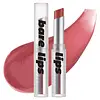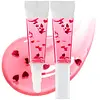What's inside
What's inside
 Key Ingredients
Key Ingredients

 Benefits
Benefits

 Concerns
Concerns

 Ingredients Side-by-side
Ingredients Side-by-side

Diisostearyl Malate
EmollientCaprylic/Capric Triglyceride
MaskingHydrogenated Polydecene
EmollientPolyglyceryl-2 Triisostearate
EmulsifyingHydrogenated Polyisobutene
EmollientBis-Diglyceryl Polyacyladipate-2
EmollientOctyldodecanol
EmollientMicrocrystalline Wax
Emulsion StabilisingParaffin
PerfumingPolyethylene
AbrasiveDimer Dilinoleyl Dimer Dilinoleate
EmollientSynthetic Wax
AbrasiveSilica Dimethyl Silylate
EmollientEthylene/Propylene Copolymer
AbrasiveCI 77491
Cosmetic ColorantCI 77492
Cosmetic ColorantCI 77891
Cosmetic ColorantParfum
MaskingCI 15850
Cosmetic ColorantPolyglyceryl-2 Diisostearate
EmulsifyingCaprylyl Glycol
EmollientGlyceryl Caprylate
EmollientCI 45410
Cosmetic ColorantWater
Skin ConditioningGlycerin
HumectantButylene Glycol
HumectantSucrose Palmitate
EmollientHydrogenated Lecithin
Emulsifying1,2-Hexanediol
Skin ConditioningMacadamia Ternifolia Seed Oil
EmollientOlea Europaea Fruit Oil
MaskingSimmondsia Chinensis Seed Oil
EmollientVitis Vinifera Seed Oil
EmollientEthylhexylglycerin
Skin ConditioningAscorbic Acid
AntioxidantBiotin
AntiseborrhoeicCyanocobalamin
Skin ConditioningFolic Acid
Skin ConditioningNiacinamide
SmoothingPantothenic Acid
Skin ConditioningPyridoxine
Skin ConditioningThiamine Hcl
MaskingTocopherol
AntioxidantDiisostearyl Malate, Caprylic/Capric Triglyceride, Hydrogenated Polydecene, Polyglyceryl-2 Triisostearate, Hydrogenated Polyisobutene, Bis-Diglyceryl Polyacyladipate-2, Octyldodecanol, Microcrystalline Wax, Paraffin, Polyethylene, Dimer Dilinoleyl Dimer Dilinoleate, Synthetic Wax, Silica Dimethyl Silylate, Ethylene/Propylene Copolymer, CI 77491, CI 77492, CI 77891, Parfum, CI 15850, Polyglyceryl-2 Diisostearate, Caprylyl Glycol, Glyceryl Caprylate, CI 45410, Water, Glycerin, Butylene Glycol, Sucrose Palmitate, Hydrogenated Lecithin, 1,2-Hexanediol, Macadamia Ternifolia Seed Oil, Olea Europaea Fruit Oil, Simmondsia Chinensis Seed Oil, Vitis Vinifera Seed Oil, Ethylhexylglycerin, Ascorbic Acid, Biotin, Cyanocobalamin, Folic Acid, Niacinamide, Pantothenic Acid, Pyridoxine, Thiamine Hcl, Tocopherol
Hydrogenated Polyisobutene
EmollientEthylhexyl Palmitate
EmollientDiisostearyl Malate
EmollientEthylene/Propylene/Styrene Copolymer
Butylene/Ethylene/Styrene Copolymer
Polyethylene Terephthalate
Methyl Hydrogenated Rosinate
PerfumingTocopheryl Acetate
AntioxidantPolyglyceryl-2 Triisostearate
EmulsifyingPolyurethane-11
Polyglyceryl-2 Diisostearate
EmulsifyingTribehenin
EmollientSorbitan Isostearate
EmulsifyingPalmitoyl Tripeptide-1
Skin ConditioningBHT
AntioxidantDehydroacetic Acid
PreservativeParfum
MaskingCI 45410
Cosmetic ColorantCI 19140
Cosmetic ColorantCI 15850
Cosmetic ColorantCI 77000
Cosmetic ColorantHydrogenated Polyisobutene, Ethylhexyl Palmitate, Diisostearyl Malate, Ethylene/Propylene/Styrene Copolymer, Butylene/Ethylene/Styrene Copolymer, Polyethylene Terephthalate, Methyl Hydrogenated Rosinate, Tocopheryl Acetate, Polyglyceryl-2 Triisostearate, Polyurethane-11, Polyglyceryl-2 Diisostearate, Tribehenin, Sorbitan Isostearate, Palmitoyl Tripeptide-1, BHT, Dehydroacetic Acid, Parfum, CI 45410, CI 19140, CI 15850, CI 77000
Ingredients Explained
These ingredients are found in both products.
Ingredients higher up in an ingredient list are typically present in a larger amount.
Ci 15850 is the pigment color red. It is an azo dye and created synthetically.
Azo dyes need to be thoroughly purified before use. This allows them to be more stable and longer-lasting.
This ingredient is common in foundations, lipsticks, and blushes. This color is described as brown/orangey red.
It has many secondary names such as Red 6 and Red 7. According to a manufacturer, Red 6 usually contains aluminum.
Learn more about CI 15850CI 45410 is a synthetic red-pigment and dye.
It often goes by both Red 28 or Red 27; manufacturers label both ingredients as CI 45410.
This dye is commonly found in makeup because it imparts a vivid color. Some types of this dye change color based on pH level and interaction with moisture:
Your skin has a natural pH of around 4.5 - 5.5.
According to the FDA, CI 45410 is not permitted for use in eye products.
Red 27 is a flourescein dye and commonly used as a fluorescent tracer in medicine.
Learn more about CI 45410Diisostearyl Malate is an emollient and most often used in lip products. It comes from isostearyl alcohol, a fatty acid, and malic acid, an AHA.
As an emollient, Diisostearyl Malate helps create a thin film on your skin to trap moisture in. This helps keep your skin soft and smooth.
Hydrogenated Polyisobutene is a synthetic polymer. Polymers are compounds with high molecular weight. Hydrogenated Polyisobutene is an emollient and texture enhancer.
In one study, Hydrogenated Polyisobutene showed better skin hydration levels than Caprylic/Capric Triglyceride. As an emollient, it helps keep your skin soft and hydrated by trapping moisture in.
Hydrogenated Polyisobutene is often used as a mineral oil replacement.
Learn more about Hydrogenated PolyisobuteneParfum is a catch-all term for an ingredient or more that is used to give a scent to products.
Also called "fragrance", this ingredient can be a blend of hundreds of chemicals or plant oils. This means every product with "fragrance" or "parfum" in the ingredients list is a different mixture.
For instance, Habanolide is a proprietary trade name for a specific aroma chemical. When used as a fragrance ingredient in cosmetics, most aroma chemicals fall under the broad labeling category of “FRAGRANCE” or “PARFUM” according to EU and US regulations.
The term 'parfum' or 'fragrance' is not regulated in many countries. In many cases, it is up to the brand to define this term.
For instance, many brands choose to label themselves as "fragrance-free" because they are not using synthetic fragrances. However, their products may still contain ingredients such as essential oils that are considered a fragrance by INCI standards.
One example is Calendula flower extract. Calendula is an essential oil that still imparts a scent or 'fragrance'.
Depending on the blend, the ingredients in the mixture can cause allergies and sensitivities on the skin. Some ingredients that are known EU allergens include linalool and citronellol.
Parfum can also be used to mask or cover an unpleasant scent.
The bottom line is: not all fragrances/parfum/ingredients are created equally. If you are worried about fragrances, we recommend taking a closer look at an ingredient. And of course, we always recommend speaking with a professional.
Learn more about ParfumPolyglyceryl-2 Diisostearate isn't fungal acne safe.
This ingredient is a form of glycerin with emulsifying and emollient properties.
As an emulsifier, this ingredient helps keep products together while adding a thick texture. The manufacturer states this ingredient has emollient properties. Emollients help keep the skin hydrated by trapping moisture in.
Polyglyceryl-2 Triisostearate is created by reacting diglycerin and isostearic acid. Due to the isostearic acid base, it may not be safe for Malassezia or fungal acne.
Learn more about Polyglyceryl-2 Triisostearate